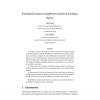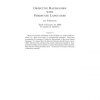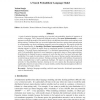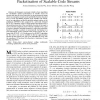CJ
2004
14 years 7 months ago
2004
An evidence theoretic classification method is proposed in this paper. In order to classify a pattern we consider its neighbours, which are taken as parts of a single source of ev...
SYNTHESE
2008
14 years 7 months ago
2008
Objective Bayesian probability is often defined over rather simple domains, e.g., finite event spaces or propositional languages. This paper investigates the extension of objectiv...
UAI
1993
14 years 8 months ago
1993
: Jeffrey’s rule of conditioning has been proposed in order to revise a probability measure by another probability function. We generalize it within the framework of the models b...
NIPS
2000
14 years 8 months ago
2000
A goal of statistical language modeling is to learn the joint probability function of sequences of words in a language. This is intrinsically difficult because of the curse of dim...
NIPS
2001
14 years 8 months ago
2001
We propose a novel clustering method that is an extension of ideas inherent to scale-space clustering and support-vector clustering. Like the latter, it associates every data poin...
ISAAC
2007
Springer
15 years 1 months ago
2007
Springer
In an uncertain data set S = (S, p, f) where S is the ground set consisting of n elements, p : S → [0, 1] a probability function, and f : S → R a score function, each element i...
DCC
2002
IEEE
15 years 6 months ago
2002
IEEE
In this paper, we present a family of new algorithms for rate-fidelity optimal packetization of scalable source bit streams with uneven error protection. In the most general settin...




